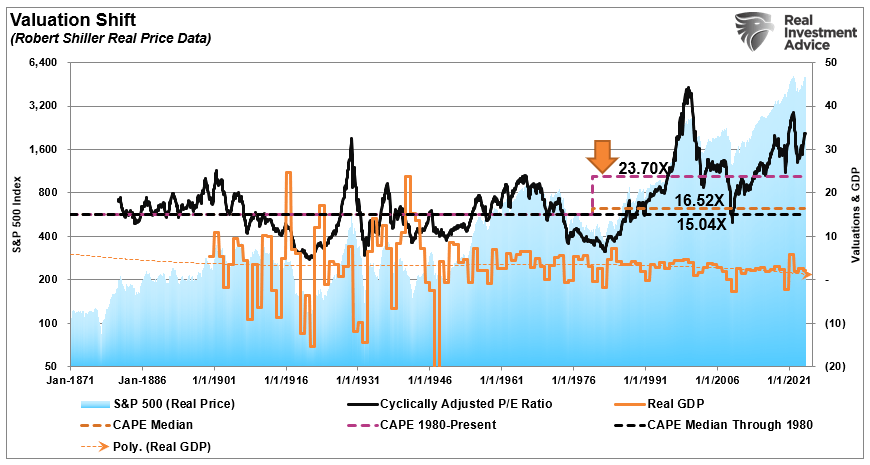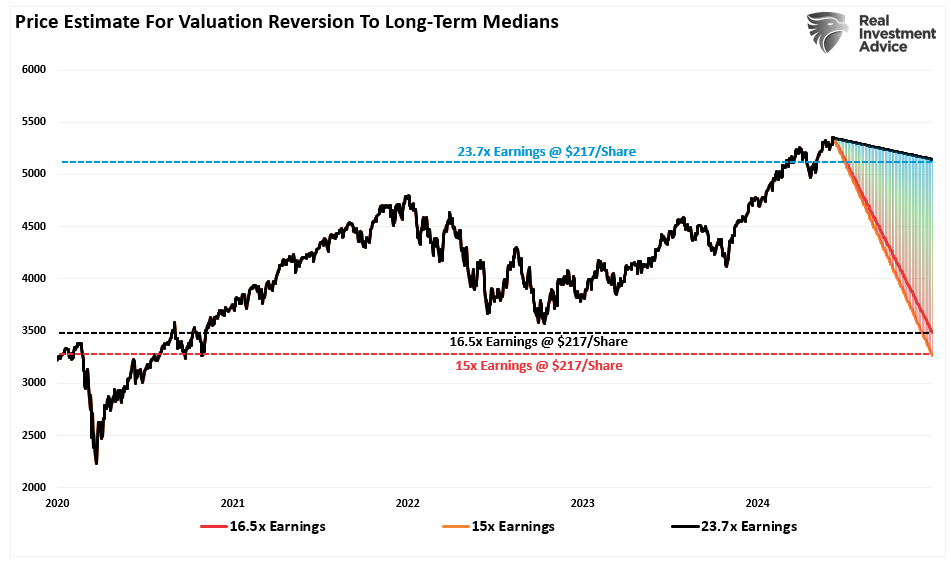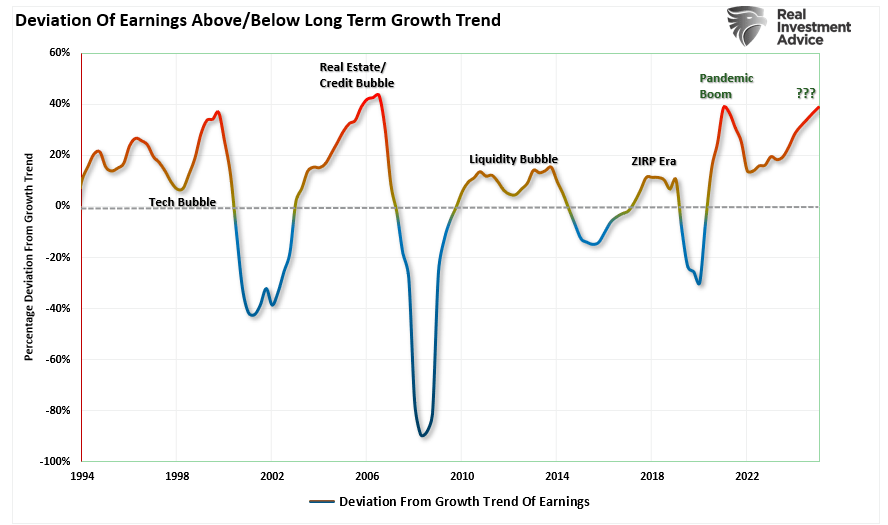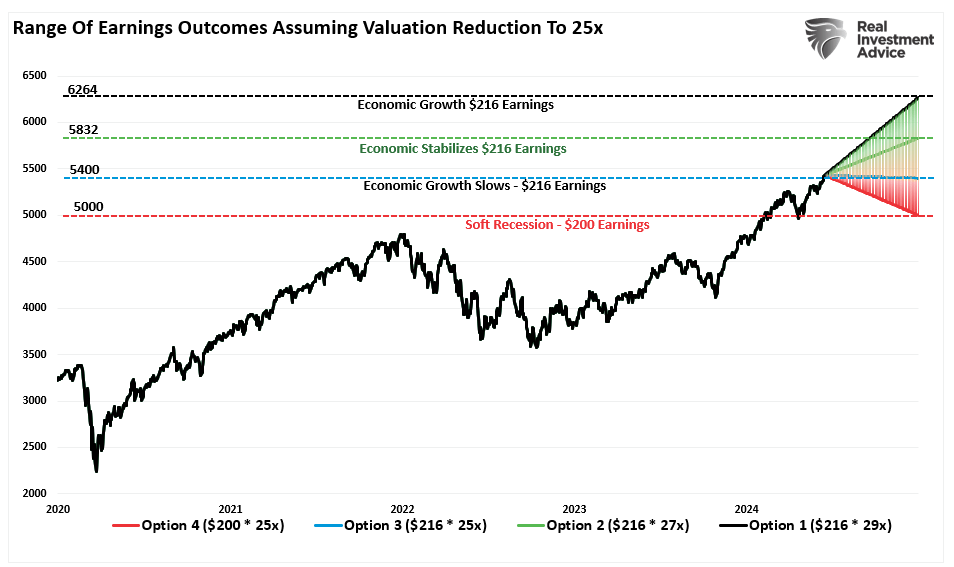Goldman Sachs lately upped its worth goal to S&P 6300 for the tip of this yr, together with Evercore ISI upping its year-end goal to 6000. Such is no surprise given the robust run within the markets this yr. Simply two weeks in the past, I posted the next chart saying:
“We must always quickly begin getting a raft of S&P 500 worth goal upgrades for year-end.”

Whereas such a daring quantity could seem unrealistic, there’s a basic case to help it.
Final week, I mentioned how there was a “Basic Shift Greater In Valuations.” In that article, we mentioned how that occurred. To wit:
“There are a lot of explanation why valuations have shifted larger over time. The rise is partly on account of financial enlargement, globalization, and elevated profitability. Nonetheless, because the flip of the century, modifications in accounting guidelines, share buybacks, and higher public adoption of investing (aka ETFs) have additionally contributed to the shift. Moreover, as famous above, the huge financial and financial interventions because the “Monetary Disaster” created a seemingly “risk-free” atmosphere for fairness threat.
The chart exhibits the obvious shift in valuations.”
- The “median” CAPE ratio is 15.04 instances earnings from 1871-1980.
- The long-term “median” CAPE is 16.52 instances earnings from 1871-Current (all years)
- The “median” CAPE is 23.70 instances earnings from 1980 to the current.


There are two essential issues to think about in regards to the chart above.
- The shift larger in MEDIAN valuations was a perform of falling financial progress and deflationary pressures, and,
- Rising ranges of leverage and debt, which eroded financial progress, facilitated larger costs.
So, the query is, “IF” valuations have completely shifted larger, what is going to the following market mean-reverting occasion seem like to reset basic valuations to a extra engaging stage?
We answered that query by analyzing present market costs and anticipated earnings to find out the form of such a valuation reversion.
As of this writing, the S&P 500 is buying and selling at roughly $5,300 (we are going to use a spherical quantity for simple math). The projected earnings for 2024 are roughly $217/share. We are able to plot the worth decline wanted to revert valuations utilizing the abovementioned median valuation ranges.
- 23.70x = 5142.90 = 3% decline
- 16.52x = 3584.84 = 33% decline
- 15.04x = 3263.68 = 38.5% decline


Nonetheless, that story’s “different facet” is the place a a number of enlargement happens.


S&P 6300 – The Different Facet Of The Story
How did we choose S&P 6300? We used a normal Fibonacci sequence to establish the logical, numerical sequence from the November 2023 lows. From these lows, an extension of 1.62% would take the market to roughly 6300 (6255, to be precise). Nonetheless, for the market to make that advance, the underlying earnings might want to help the continued rise.


As famous within the earlier article, valuation contractions occur throughout recessionary and bear market intervals. Throughout such a part, the exuberance of the market realigns the worth of the market with the underlying fundamentals. Nonetheless, a number of expansions are underway earlier than the start of the reversion course of. Throughout this bullish part, Wall Avenue analysts proceed to ratchet earnings estimates larger to justify rising costs. At present, we’re within the a number of enlargement part, the place analysts are dramatically rising earnings estimates to extra excessive ranges. As proven, the earnings estimates for 2025 are at a file deviation from the long-term exponential progress pattern.


So, how can the S&P 500 get to 6300? We are able to use present Wall Avenue estimates to work backward via the valuation course of. As we did beforehand, we normally have a look at the market’s worth and decide the “truthful worth” of the market primarily based on anticipated earnings. On this case, we are going to take the denominator (earnings) of the valuation equation to seek out the “truthful worth” of the market.
Whereas Goldman is 6300 for the tip of this yr, for this thought experiment, we are going to use S&P World’s present estimates of $216/share for the tip of 2024. For Goldman’s estimate of 6300, trailing one-year valuations will rise to 29x earnings. Nonetheless, we may even assume some decrease valuation of 27x and 25x earnings by year-end if financial progress continues to gradual. Moreover, we are going to take into account a drop in earnings to $200/share if the economic system begins heading right into a delicate recession. Nonetheless, provided that Wall Avenue estimates are at all times overly optimistic, a deeper low cost in earnings is feasible. Nonetheless, these parameters give us the next outcomes.
- $216/share * 29x Trailing Earnings = 6264 (Assumes continued financial progress)
- $216/share * 27x Trailing Earnings = 5832 (Assumes financial progress stabilizes.)
- $216/share * 25x Trailing Earnings = 5400 (Assumes financial progress slows additional)
- $200/share * 25x Trailing Earnings = 5000 (Assumes a light financial recession)
As we did beforehand, we will use these forecasts to construct a chart exhibiting the vary of potential outcomes over the following 6 months.


These outcomes are only one set of assumptions. By adjusting valuation and earnings expectations, we might create infinite potentialities. The aim of the train, nevertheless, is to ascertain an affordable vary of potentialities for the market on the finish of the yr. As proven, the vary of potential outcomes is broad from market ranges on the time of this writing. The bullish argument of “no recession” suggests a potential upside from 7.4% to fifteen%. Nonetheless, if the economic system slows or slips right into a delicate recession, the potential draw back ranges from a -1% loss to -8%.


Challenges Stay
Let me state that I don’t know what the following 6 to 18 months maintain in retailer. As famous, there are an infinite variety of potentialities. What occurs within the November election, Fed coverage, and the potential for a recession will all have an effect on a type of outcomes.
Right here is our concern with the bullish state of affairs. It solely will depend on a “no recession” end result, and the Fed should reverse its financial tightening. The difficulty with that view is that IF the economic system does certainly have a delicate touchdown, there isn’t any cause for the Federal Reserve to reverse its steadiness sheet discount or lower rates of interest drastically.
Extra importantly, the rise in asset costs continues to ease monetary circumstances, preserving inflation “sticky,” thereby eroding client buying energy. The bull case additionally means that employment stays robust, together with wage progress, however there’s clear proof of abrasion on each.
Whereas the bullish state of affairs of S&P 6300 is feasible, that end result faces many challenges heading into 2025, given the market already trades at pretty lofty valuations. Even in a “delicate touchdown” atmosphere, earnings ought to weaken, making present valuations more difficult to maintain.
Our greatest guess is that actuality lies someplace within the center. Sure, there’s a bullish state of affairs by which earnings decline, and a financial coverage reversal leads traders to pay extra for decrease earnings. Nonetheless, that end result has a restricted lifespan as valuations matter to long-term returns.
As traders, we should always hope for decrease valuations and costs, which provides us the perfect potential for long-term returns. Sadly, we don’t need the ache of getting there.
No matter which state of affairs performs out in real-time, there’s a substantial threat of poor returns over the following 6-18 months. As traders, we should handle the chance of an surprising flip of occasions undermining Wall Avenue’s continued optimistic views.
In spite of everything, the maths is simply the maths.
Submit Views: 1,184
2024/06/25